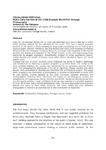Visualizing Portugal: Pedro Cid’s Pavilion at the 1958 Brussels World Fair through Photography

Use this link to cite
http://hdl.handle.net/2183/16250Collections
- Investigacion (ETSAC) [511]
Metadata
Show full item recordTitle
Visualizing Portugal: Pedro Cid’s Pavilion at the 1958 Brussels World Fair through PhotographyDate
2015Citation
Río Vázquez, A.S., Blanco Agüeira, S. (2015) “Visualizing Portugal: Pedro Cid’s Pavilion at the 1958 Brussels World Fair through photography”, en Trevisan, A., Maia, M.H. y Moreira, C.M. (Eds.), Photography & Modern Architecture Conference Proceedings. Porto: Centro de Estudos Arnaldo Araújo. 300-317
Abstract
[Abstract] Expo 58, the Brussels Worlds Fair in 1958 was described as a vanity trade fair in which every building claimed for the attention of the public. This was a logical approach because of the nature of these exhibitions: large-scale promotional events looking for a massive public interest. Therefore, the first World's Fair since 1939 revealed uninhibited structures like the strangely menacing Atomium, the huge steel dragonfly of the French pavilion, the folding tent designed for the Philips Pavilion, or the Civil Engineering Arrow conceived by Belgian engineers. Nevertheless, despite of these spectacular spaces, unique facades and tensile structures, some other nations decided in favour of a much smaller scale.
Portugal was one of those countries which embraced the world of modern technology and architecture by featuring a pavilion designed by architect Pedro Cid. Unlike in the more symbolic displays, the country was represented by an advanced exercise of pure form. Two photographers specialized in the art of capturing images, Horácio and Mário Novais, were committed to illustrate and document the architectural project. This paper seeks to analyze the importance of photography in creating an abstraction of reality with its own identity, created partially by the close connection between architects and photographers. Pursuing these objectives, the images of the Portuguese pavilion are compared to the Yugoslavian, Swiss, German and British. Positioned directly across from the Portuguese pavilion, these mentioned buildings also revealed a crystalline approach to form. All of them had a refined architectural style, shared a large green area and were placed very close to each other. However, the views shown are very different. Photography is therefore an essential tool in the construction of Modernity.
Keywords
Architecture
Photography
Portugal
Novais
Pastor
Expo 58
Photography
Portugal
Novais
Pastor
Expo 58
ISBN
978-972-8784-63-8





